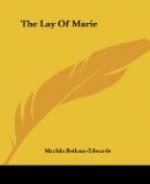In the last place, the Harleian MS. No. 4333, ascribes the translation to King Henry. The Normans were acquainted with the fables of Aesop, or, at least, those which were attributed to him during the middle ages. The collateral heirs of Raoul de Vassy, who died in 1064, when, after the death of William the Conqueror, they found means to establish their claims against Robert Courthose; in asserting it, reproach his father with having made the lion’s partition in seizing Upon their inheritance.[31]
This proverbial expression very clearly shews that the writings of the Greek fabulist, or at least of those who had followed him, were known to the Normans from the eleventh century. It is possible, therefore, that Henry I. might have studied and translated them into English. Again, all historians agree in giving this prince the title of Beauclerk, though no one has assigned any reason for a designation so honourable: and this opinion would justify history, which has given to Henry a name with which authors alone were dignified.
Whether Mary followed the English version literally cannot be ascertained, as we do not even know whether it now exists; and are therefore under the necessity of collating her fables with those of the middle ages: and it appears, she translated from the English 104 fables into French verse; and of this number there are 65, the subjects of which had already been treated of by Aesop, Phaedrus, Romulus, and the anonymous author of the Fabulae Antiquae, published by Niland.
The English translation was not only compiled from these different authors, but from many other fabulists, whose names are unknown to us; since, out of the 104 fables of Mary, there are 39 which are neither found in the before mentioned authors, nor in any other known to us.
The English version contained a more ample assemblage of fables than that of Mary, since out of the 56 in the Royal MS. 15 A. VII, which made a part of the former, it appears that she made a selection of subjects that were pleasing to her, and rejected others. It is very singular, that England appears to have had fabulists during the ages of ignorance, whilst Athens and Rome possessed theirs only amidst the most refined periods of their literature.
Some may, perhaps, be disposed to conclude that the 39 additional fables were actually composed by Mary; but I believe, upon reflection, this opinion must be abandoned. She terms her work a translation, glories in the enterprize; and, if it had been only in part the labours of her genius, would scarcely have passed over that circumstance in silence.
Monsieur Le Grand has published 43 of Mary’s fables in prose. His translation, however, is not always literal; and seems, in many places, to have departed from the original. He has likewise published many of the fabliaux, or little stories, which he has unadvisedly attributed to the transcribers of them, and which belong indisputably to her.




